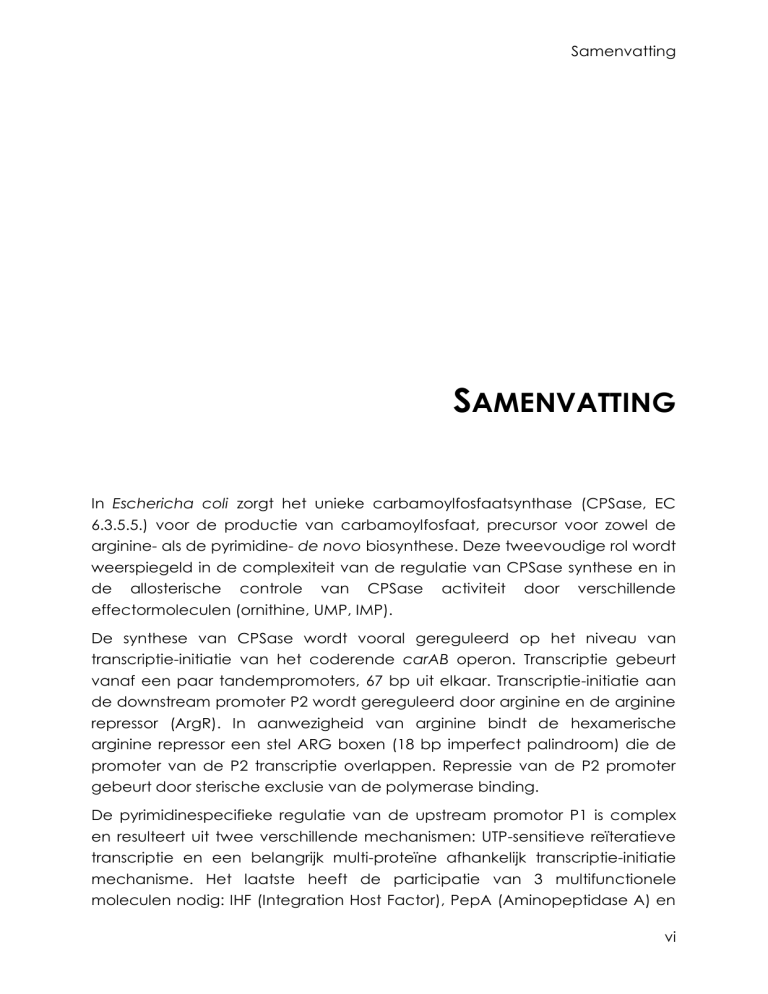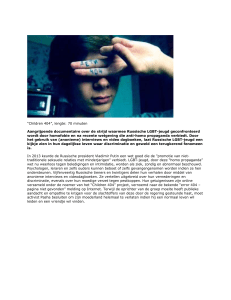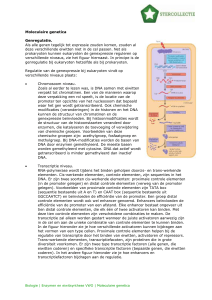
Samenvatting
SAMENVATTING
In Eschericha coli zorgt het unieke carbamoylfosfaatsynthase (CPSase, EC
6.3.5.5.) voor de productie van carbamoylfosfaat, precursor voor zowel de
arginine- als de pyrimidine- de novo biosynthese. Deze tweevoudige rol wordt
weerspiegeld in de complexiteit van de regulatie van CPSase synthese en in
de allosterische controle van CPSase activiteit door verschillende
effectormoleculen (ornithine, UMP, IMP).
De synthese van CPSase wordt vooral gereguleerd op het niveau van
transcriptie-initiatie van het coderende carAB operon. Transcriptie gebeurt
vanaf een paar tandempromoters, 67 bp uit elkaar. Transcriptie-initiatie aan
de downstream promoter P2 wordt gereguleerd door arginine en de arginine
repressor (ArgR). In aanwezigheid van arginine bindt de hexamerische
arginine repressor een stel ARG boxen (18 bp imperfect palindroom) die de
promoter van de P2 transcriptie overlappen. Repressie van de P2 promoter
gebeurt door sterische exclusie van de polymerase binding.
De pyrimidinespecifieke regulatie van de upstream promotor P1 is complex
en resulteert uit twee verschillende mechanismen: UTP-sensitieve reïteratieve
transcriptie en een belangrijk multi-proteïne afhankelijk transcriptie-initiatie
mechanisme. Het laatste heeft de participatie van 3 multifunctionele
moleculen nodig: IHF (Integration Host Factor), PepA (Aminopeptidase A) en
vi
Samenvatting
PyrH (UMP-kinase). Het werd aangetoond dat al deze elementen moeten
samenwerken in de opbouw van een specifiek regulatorisch nucleoproteïne
complex waarbij IHF en PepA hoofdzakelijk een structurele rol zouden
vervullen en PyrH de sensor van de wijzigingen in de nucleotidepool zou zijn.
Daarnaast wordt, bij nutritionele stress, de P1 promoter activiteit negatief
gereguleerd door de stringent respons.
Deze studie werd toegespitst op volgende zaken: 1- het aantonen en
ontrafelen van de purinespecifieke repressie van de P1 promoter, 2- het
bepalen van de rol van de linkers, de tussenliggende sequenties die de
verschillende bindingssites verbinden, in de pyrimidine- en purine-afhankelijke
regulatie van P1, en 3- het bestuderen van de proteïnegeïnduceerde
vervorming van het operator-DNA.
In eerste instantie werd aangetoond dat purines de P1 promotoractiviteit
inderdaad represseren. Stroomopwaarts van P1 hebben wij een 16 bp stretch
gevonden die een hoge gelijkenis vertoont met de PUR box consensus. Het
werd aangetoond dat gezuiverd PurR deze potentiële PUR box bindt op een
sequentiespecifieke en ligand-afhankelijke manier. Geactiveerd PurR maakt
gebruik van de pyrimidinespecifieke nucleoproteïne structuur om zijn effect
op carAB transcriptie uit te oefenen en dus zijn de purine- en pyrimidine
regulatie van P1 promotoractiviteit zowel functioneel als structureel
gekoppeld. PepA speelt hierin een sleutelrol. Deze koppeling tussen purineen pyrimidine-gemediëerde repressie is uniek en wordt zelfs niet
teruggevonden in andere pyrimidine-biosynthese genen waarop purines en
PurR ook een controle uitvoeren.
Naast deze onverwachte koppeling tussen de repressie door purines en de
pyrimidinespecifieke repressie vertoont de purinespecifieke repressie van P1 in
E. coli nog een aantal afwijkende karakteristieken in vergelijking met andere
PurR gemediëerde transcriptiecontroles. Allereerst is er de ongewone ligging
van de target site van PurR die zeer ongewoon is; 120 bp upstream van de P1
transcriptie-initiatie site. Meestal overlapt de PUR box de promoter ofwel
fungeert PurR als een versperring voor een elongerende polymerase, als hij
stroomafwaarts bindt. Deze ongewone ligging van de carAB PUR box is
hoogstwaarschijnlijk gerelateerd met de structurele en functionele koppeling
van de P1 purinespecifieke repressie met de pyrimidinespecifieke regulatie.
Een tweede unieke en uiterst opmerkelijke eigenschap van de carAB PUR box
is de guanine op positie 8. In andere PUR boxen vindt men op positie 8
meestal een adenine terug, soms een cytosine of thymine maar nooit een
vii
Samenvatting
guanine. Vorige studies voorspelden dat een guanine op deze positie zeer
ongunstig zou zijn aangezien die een sterische clash zou veroorzaken met de
repressor. In vivo en in vitro onderzoek wijst echter uit dat guanine op positie 8
toch een functionele operator geeft, hoewel de binding niet optimaal is.
Daarnaast hebben wij ook een model geconstrueerd om aan te tonen hoe
de repressor toch met de carAB operator kan binden zonder een sterische
clash te veroorzaken.
Bijkomend onderzoek wees erop dat een overmaat purines antagonistische
effecten uitoefent op de P1 activiteit: een indirect, stimulerend effect,
vermoedelijk afkomstig uit de crosstalk tussen de purine en pyrimidine
biosyntheseweg en een directe, PurR-afhankelijke repressie, resulterend in
een netto tweevoudige repressie.
De bindingssites van de regulatorische proteïnen, betrokken in de purine- en
pyrimidine-specifieke repressie, liggen verspreid over een controlegebied van
ongeveer 450 bp, met grote tussenliggende sequenties. Wij hebben onze
aandacht gericht op deze linker sequenties en onderzochten het belang van
onderlinge afstand en fasering tussen de regulatorische bindingssites door het
introduceren van inserties en deleties van verschillende lengte, en
combinaties daarvan, in de vier linkers.
De analyse van halve en volledige draai inserties en deleties in verschillende
zones van de operator wijst erop dat de pyrimidine-specifieke repressie van
P1 activiteit zeer gevoelig is voor perturbaties in de positionering van de
verschillende regulatorische bindingssites op het oppervlak van de helix. De
systematische analyse van de lengte van linker L2 toont aan dat de afstand
tussen de twee PepA boxen, ten opzichte van elkaar en van de promotor,
strikt bepaald is voor zowel de pyrimidine- als de purine-specifieke repressie.
Gelijkaardig, zijn de afstand en fasering van de IHF en PEPA2 sites strikt
beperkt, maar enkel voor de pyrimidinespecifieke repressie. Voor de
purinespecifieke repressie is een correcte alignering van deze sites niet vereist,
en de IHF bindingssite is zelfs niet onontbeerlijk. Zodus blijkt PepA het
sleutelelement te zijn en de correcte ligging van PepA in het regulatorisch
nucleoproteïne complex is een absolute vereiste voor zowel de pyrimidine- als
de purine-gemediëerde repressie van carAB.
Bij constructen met de combinatie van een insertie en een deletie van gelijke
lengte in een enkele linker, liggen alle reeds geïdentificeerde regulatorische
bindingssites en de promoter op de correcte positie, enkel de lokale linker
sequentie is veranderd. In alle, behalve één, linkers resulteerde deze
viii
Samenvatting
combinatie in een bijna volledig herstel van de pyrimidinespecifieke repressie,
wat er op wijst dat de linker sequentie weinig of geen belang heeft.
L1, naast de promoter gelegen, is de enige linker waarin de combinatie van
een 5 bp deletie en een 5 bp insertie (ins3+del8) de pyrimidine-specifieke
repressie niet volledig hersteld (3-voudige vermindering). De purinespecifieke
repressie was onveranderd. De ins3+del8 operator verschilt van het wilde type
op
twee
posities:
een
G-C
in
de
plaats
van
een
AT op positie –60 en A-T naar T-A verandering op positie –57. Deze mutaties
bevinden zich in een 17 bp stretch die enkel bestaat uit A en T residu’s. Dit
resultaat wijst erop dat dit promoter-proximaal gebied gecontacteerd wordt
door een pyrimidine-specifiek component van het regulatorisch complex
(mogelijk PyrH, de sensor van het systeem).
De analyse van een P1 mutant (P1-O1), losgekoppeld van de downstream
promoter P2 en waarbij het gehele upstream gebied vanaf positie –40
verwijderd werd, toonde aan dat het A+T-rijk gebied upstream van het -35
element niet functioneert als een Upstream Promoter (UP) element.
Tenslotte hebben we de DNA vervormingen, geïnduceerd door het binden
van de regulatorische proteïnen, geanalyseerd. We hebben de proteïnegeïnduceerde buiging door PurR, ArgR, IHF en PepA bepaald en toonden
aan dat PepA het operator DNA wikkelt. PurR en ArgR induceren een buiging
van 97° en 99°, respectievelijk. IHF induceert een bocht van 130°. PepA
brengt het grootste effect teweeg: de proteïne wikkelt het DNA met 240° en
condenseert meer dan 200 bp in het globulair nucleoproteïne complex.
Volume analyse toonde aan dat slechts één PepA hexameer aanwezig is in
het PepA-DNA complex, wat betekent dat één enkel hexameer beide PepA
boxen bindt. Alle proteïnen geïnduceerde hoeken in het controle gebied van
carAB zijn bijna of groter dan 100°. De conformatie van het operator DNA
wordt dus uitermate sterk verstoord en vervormd na de binding van deze
regulatorische proteïnen. Deze vervormingen zijn essentieel voor de werking
van het regulatorisch mechanisme.
Wij hebben een model voorgesteld voor de binding van PepA aan de carAB
operator. Beide PepA boxen komen te liggen in een DNA-bindende groeve
op de zijde van het PepA hexameer (dimeer van trimeren). Het
tussenliggende DNA ligt in een loop over de tussenliggende groeve. Dit DNA
en de groeve kunnen echter geen contact maken, aangezien ze in een
tegengestelde richting lopen. In deze loop ligt de PUR box, vrij om door PurR
gebonden te worden.
ix
Samenvatting
SUMMARY
In E. coli, a unique carbamoylphosphate synthase (CPSase, EC 6.3.5.5.),
encoded by the carAB operon, provides carbamoylphosphate for the
biosynthesis of both arginine and the pyrimidines. Its dual role is reflected in
the complexity of the regulatory mechanisms modulating carAB transcription
and the allosteric control of CPSase activity by different effector molecules
(ornithine, UMP, IMP).
The production of CPSase is essentially regulated at the level of transcription
initiation at two tandem promoters. The downstream promoter P2 is regulated
by arginine and the arginine repressor. In the presence of arginine, the
arginine repressor will bind to two arginine boxes (18bp imperfect
palindrome), overlapping the transcription initiation site and by doing so,
excluding the RNA-polymerase from the promoter.
The major protein-dependent transcriptional initiation control of the upstream
promoter P1 requires the participation of at least three multifunctional
proteins: IHF (Integration host factor), PepA (aminopeptidase A) and PyrH
(UMP-kinase), which cooperate in the elaboration of a regulatory
nucleoprotein complex. IHF and PepA are assumed to play an important
structural role in the establishment of pyrimidine-specific repression, whereas
PyrH would be the sensor of the pyrimidine-specific signal. P1 is also down
regulated by UTP-sensitive reiterative transcription and, upon nutritional stress,
by the stringent control.
This study focused on the following aspects: 1- to demonstrate and unravel
the purine-specific repression of the P1 promoter, 2- to determine the role of
the linkers, the intervening sequences that connect the different binding sites,
in the pyrimidine- and purine-dependent regulation of P1, and 3- to
investigate the protein-induced deformations of the operator DNA.
Here we show that excess purines exert a negative effect on P1 transcription
activity. Upstream of P1 we found a 16 bp stretch that exhibits high sequence
similarity with the consensus PUR box. Purified PurR protein was shown to bind
to this potential PUR box in a sequence-specific and ligand-dependent
manner. Activated PurR relies on the pyrimidine-specific nucleoprotein
structure to exert its effect, and thus, purine and pyrimidine-specific regulation
x
Samenvatting
of P1 activity are structurally and functionally coupled. PepA is the key
element for this coupling. The coupling is unprecedented, even for other pyr
genes where PurR-mediated repression co-regulates transcription. Besides this
unique coupling, PurR-specific repression of P1 in E. coli holds a few more
remarkable characteristics in comparison to other PurR-mediated repressed
systems. There is the atypical position of the PUR box of P1 120 bp upstream of
the transcription start point. Usually, PurR target sites overlap the promoter or
act as a roadblock, when situated downstream of the transcription start point.
The odd position of the carAB PUR box is most likely linked to the structural
and functional coupling of the P1 purine-specific repression to the pyrimidinespecific regulation.
A second unique and most remarkable feature of the carAB PUR box is the
guanine at position eight. In other PUR boxes position 8 is occupied by an
adenine, sometimes a thymine or a cytosine, but never a guanine. Previous
studies predicted guanine to be extremely unfavourable, as a steric clash
with the protein would occur. Our in vivo and in vitro analyses indicate that
guanine at position eight, constitutes a functional operator, though binding is
not optimal. Modelling studies indicate that the predicted steric clash can be
avoided, leading to a structure with suboptimal contacts.
Additional mutant studies indicated that excess purine exerts antagonistic
effects on P1 activity: an indirect stimulation related to the variation in the
internal purine and pyrimidine nucleotide pools and a direct down regulation
by purines and the purine repressor, resulting in a net twofold repression.
The binding sites for the regulatory proteins involved in the purine- and
pyrimidine-specific repression are spread over a control region of about 450
bp with large intervening sequences. We focused on these linker sequences,
investigating the importance of the phasing and spacing of the regulatory
targets by introducing insertion and deletion mutations of various lengths, and
combinations thereof, in the four linkers.
The analysis of half and full-turn insertion and deletion mutants in different
zones of the operator, indicate that pyrimidine-dependent repression of P1
activity is highly sensitive to perturbations of the distribution of regulatory
targets on the surface of the double stranded helix. Moreover, the systematic
analysis of the L2 linker length demonstrates that the two PepA binding sites
must be properly aligned, also relative to the promoter, and their separation is
equally strictly constrained in both, pyrimidine and purine-mediated
repression. Similarly, the phasing and the spacing of the IHF and PEPA2 sites is
xi
Samenvatting
strictly constrained, but for the pyrimidine-specific repression only. A correct
alignment of these sites is not required, and the IHF binding site is even
dispensable for purine-mediated regulation. Thus, PepA turns out to be the
key structural element and correct localisation of PepA within the higher
order regulatory nucleoprotein complex is an absolute prerequisite for the
establishment of both pyrimidine and purine-mediated repression
Constructs bearing the combination of an insertion and a deletion of equal
length within a single linker have all previously identified regulatory binding
sites and the promoter correctly positioned, only the local linker sequence is
changed. In all but one linker, this combination resulted in a nearly
completely restored pyrimidine-specific repression, indicating that the linker
sequence is of little or no importance. Only in the linker L1, proximal to the
promoter, did the combination of a 5 bp insertion and a 5 bp deletion
(ins3+del8), result in an approximately three-fold reduction of P1 repressibility
by pyrimidines. The purine-specific repression was unchanged. The ins3+del8
double mutation changes the operator sequence at just two positions: a G-C
instead of a T-A (-60) and an A-T to T-A (-57) switch, both within a 17 bp A-T
stretch. This result suggests that this promoter proximal region contains a
target that would be contacted by a component of the pyrimidine-specific
regulatory complex, possibly PyrH, the sensor of the system.
The analysis of a P1 derivative (P1-O1), disconnected from its downstream
tandem partner (P2) and devoid of its upstream control region, demonstrated
that the A+T rich region upstream of the -35 element does not function as a
UP element.
Finally, we analysed the DNA deformations induced by the binding of the
regulatory proteins. We determined the protein-induced bends of PurR, ArgR,
IHF and PepA and revealed the extent of the PepA-induced wrapping of the
operator DNA. PurR and ArgR induce a bend of 97° and 99°, respectively. IHF
brings about a U-turn of 130°. PepA has the largest effect: it wraps the
operator DNA by 240° and condenses over 200 bp in the globular
nucleoprotein complex. Volume analysis revealed that only one PepA
hexamer is present in the PepA-DNA complexes, indicating that a single
hexamer binds both PEPA boxes. All protein-induced bends at the carAB
control region are near or over 100°, so the conformation of the operator DNA
is comprehensively distorted and widely remodelled after binding of these
regulatory proteins. These deformations are essential to the functioning of the
regulatory mechanisms.
xii
Samenvatting
We proposed a model for the binding of PepA to the carAB operator DNA.
The two PEPA boxes reside in two DNA-binding grooves on the side of the
PepA hexamer (dimer of trimers). The intervening DNA is looped around the
intervening groove. No contacts are made between this loop and the groove
as they run in opposite directions. Within this loop sits the PUR box, free to
contact PurR.
xiii











